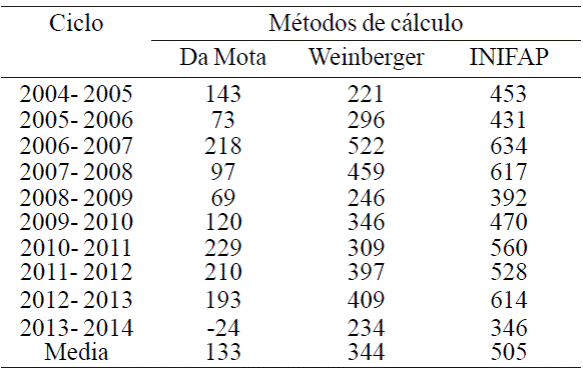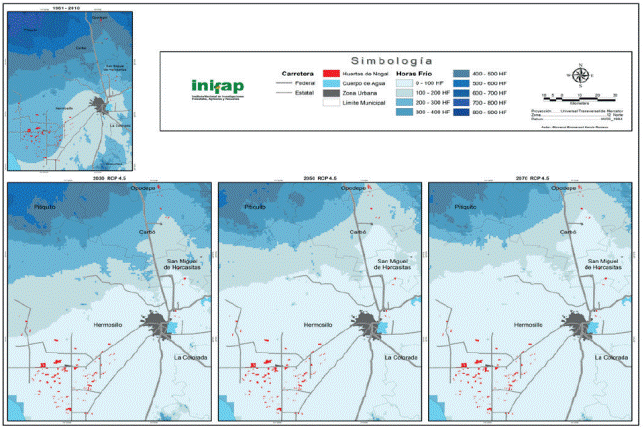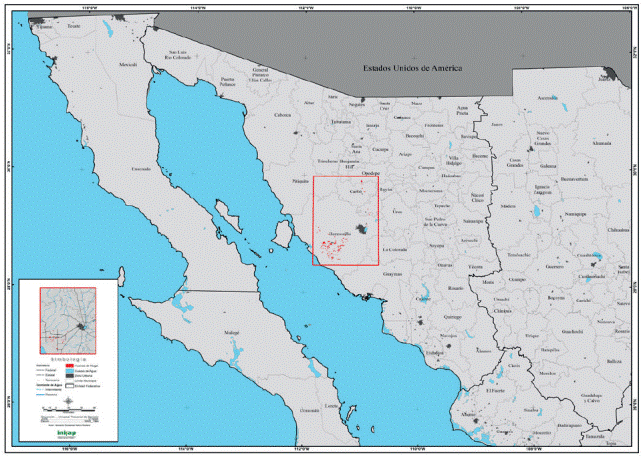Services on Demand
Journal
Article
Indicators
-
 Cited by SciELO
Cited by SciELO -
 Access statistics
Access statistics
Related links
-
 Similars in
SciELO
Similars in
SciELO
Share
Revista mexicana de ciencias agrícolas
Print version ISSN 2007-0934
Rev. Mex. Cienc. Agríc vol.7 spe 13 Texcoco Jan./Feb. 2016
Articles
Effect of climate change on the accumulation of cold hours in the pecan region from Hermosillo, Sonora
1 Campo Experimental Costa de Hermosillo-INIFAP. Pascual Encinas Félix No. 21. Colonia La Manga. Hermosillo, Sonora. C. P. 83220. (nunez.humberto@inifap.gob.mx).
2 Campo Experimental Centro-Altos de Jalisco-INIFAP. INIFAP-CIRPAC. Tepatitlán, Jalisco. (ruiz.ariel@inifap.gob.mx; geog.vanni@gmail.com).
3 Comité Estatal de Sanidad Vegetal de Sonora. (javier.valenzuela@cesaveson.com; alejandro.lagunes@cesaveson.com).
4 Campo Experimental Pabellón. INIFAP-CIRNOC. Pabellón, Aguascalientes. (ruiz.osias@inifap.gob.mx).
Global warming is evident, as shown by the increases in global average air temperature and from the ocean. Crops can be favored by increases in atmospheric carbon dioxide, but the increase in temperature will affect the development of deciduous fruit trees such as pecan (Carya illinoinensis K. Koch), which require an accumulation of cold to break the dormancy period. For the pecan area from Hermosillo, Sonora, current weather maps and future scenarios (2030, 2050 and 2070) for representative concentration pathways of greenhouse gases (RCP) 4.5 and 8.5 were obtained. There is a strong increase in average temperature between December and January (+2°C) even from the scenario in 2030 with RCP 4.5 (stable), along with a decrease in cold hours accumulated during this period 100 HF, so that in the future should generate pecan cultivars with low cold requirement or to displace pecan orchards to regions with more accumulation, in order to maintain sustainable productivity of this crop.
Keywords: cold hours; pecan; temperature
El calentamiento del sistema climático es evidente, como lo muestran los aumentos del promedio mundial de la temperatura del aire y del océano. Los cultivos pueden verse favorecidos por los aumentos de bióxido de carbono atmosférico, pero el incremento de la temperatura afectará el desarrollo de frutales caducifolios como el nogal pecanero (Carya illinoinensis K. Koch), que requieren una acumulación de frío para romper el período de dormancia. Se obtuvieron para el área nogalera de la región de Hermosillo, Sonora, mapas de la climatología actual, así como escenarios futuros (2030, 2050 y 2070), para las trayectorias representativas de concentración de gases efecto invernadero (RCP) 4.5 y 8.5. Se observa un fuerte incremento de la temperatura media entre diciembre y enero (+2 °C) incluso desde el escenario del año 2030 con el RCP 4.5 (estable), a la par de un decremento de las horas frío acumuladas en ese período de 100 HF, por lo que en un futuro se deberán generar cultivares de nogal de menor requerimiento de frío y/o desplazar las huertas de nogal a regiones con mayor acumulación, para poder mantener sustentable la productividad de este cultivo.
Palabras clave: horas frío; nogal pecanero; temperatura
Introduction
The process of rest in temperate fruit is a characteristic that inhibits growth, which can only be terminated if the bud is exposed to low temperatures for a certain time (Diaz- Montenegro, 1987). The existence of cold requirement from pecan outbreaks to break dormancy and grow normally was first suggested by Waite (1925). The lack of cold apparently delays sprouting, increases fruit drop and yield decreases when the pecan is grown in climates without enough cold hours (Van Horn, 1941; Nasr and Hassan, 1975). Lack of knowledge to predict the adequacy the dormancy period, prevents the development of pecan growth models that could be useful in applications such as pest management, plant propagation, and assessment of climate adaptation of cultivars (Smith et al., 1992).
Demand for cold by pecan has been confirmed, and one study reported the hours required to break dormancy, establishing 500 for cultivars 'Desirable' and 'Mahan' and 600 for 'Stuart' (McEachern et al., 1978). Another study reported 300 to 400 for 'Mahan', 'Success', 'Desirable' and 'Schley' and 700 to more than 1 000 for 'Stuart' (Amling and Amling, 1980). In both studies, 'Stuart' had a higher cooling demand than other cultivars evaluated. Van Horn (1941) reported that when planting 'Burkett' trees at low altitudes in Arizona, USA, these were seriously affected by delay in sprouting, while 'Humble' sprouted normally in the spring. The differences between the two cultivars were attributed to an increased need for cold of "Burkett" than "Humble".
Warming of the climate system is unequivocal, as proven by the increases in global average air temperature and from ocean, widespread melting and rising global average sea level. In the period 1995-2006, eleven years are among the warmest in the instrumental record of global surface temperature (since 1850). The linear trend to 100 years (1906-2005), estimated at 0.74°C (between 0.56°C to 0.92°C) is higher than the trend 1901 to 2000 corresponding to 0.6°C (between 0.4 and 0.8°C). This increase in temperature is over the globe and is greater at higher northern latitudes. Land regions have warmed more quickly than the oceans (IPCC, 2007).
Globally, the 1990s and 2000s have been the warmest. Is noteworthy the period between 1910 and 1945 with an increase of global temperature of 0.14 °C and the period 1976 to 1999 with an increase in temperature of 0.17°C (Salinger, 2005; Jones et al., 2009). Studies have been conducted in different regions of the world to know the trends in temperature and determine their differences regarding the current climate, using sets of 30 years to reduce systematic errors and to allow detecting small variations (anomalies) in temperatures (Leroy, 1999).
Due to the increase in temperature that has occurred in all seasons, winter has also been affected by decreasing the amount of cold or cold units that accumulate during the season and that are necessary to break the winter dormancy of deciduous fruit (Jindal and Mankotia, 2004; Luedeling et al., 2009; Yu et al., 2010).
In order to ensure proper planning of agricultural development in the short and medium term in a region, it is necessary to estimate future climate scenarios, the availability of agro-climatic resources, including the accumulation of cold, in order to count with enough information to design and implement adaptation measures to avoid or minimize as far as possible the negative impacts of climate change. Therefore, the objective of this study was to evaluate the effect of climate change in the XXI century in the accumulation of cold in the pecan region of Hermosillo, Sonora.
Materials and methods
Study area
The study was developed for the growing conditions of the agricultural region of Hermosillo, Sonora, Mexico. The city of Hermosillo is located west of the State of Sonora, Hermosillo is the capital located between parallels 29° 10' and 28° 59' north latitude and between the meridians 111° 4' and 110° 55' west longitude at an altitude of 282 masl; bordered on the northeast by Carbo and San Miguel de Horcasitas; to the east Ures and Mazatlan; southeast La Colorada and Guaymas; northwest Pitiquito and southwest with the Gulf of California (Figure 1).
Calculation method for cold hours
Two methods accuracy regarding the estimation of cold hours in winter were evaluated:
a) Da Mota method (Diaz, 1987), which calculates the monthly accumulated cold hours as follows:
HF= 485.1 - 28.52 Xi
Where: Xi is the average temperature for the months of November, December, January and February.
b) Weinberger method (Ortiz, 1987), which relates the number of cold hours accumulated with the average of mean temperatures from December and January, with the following equation:
HF= 2124.85 - 125.23 Xi
Where: Xi is the average of the mean temperatures from December and January (°C).
The assessment of the accuracy of these methods was made comparing the values of accumulated cold hours with this methodology against total cold hours total accounted directly through ten-minute data from automated agro-meteorological station CECH-INIFAP from the Agroson Network (www.agroson.org.mx). Calculations and assessment of the two indirect methods were made taking into account a series of ten winter cycles (2004-2005 to 2013- 2014). The direct calculation of cold hours was performed by counting effective cold hours (HFE), using the following expression, which will be called the INIFAP method:
HFE= HF-HC
Where: HF are the hours with temperatures> 0 and ≤ 10°C; while HC are the hours with temperature> 25°C.
The adjustment of indirect methods to calculate cold hours were assessed through Pearson ́s correlation coefficient, establishing the correlations Da Mota vs INIFAP and Weinberger vs INIFAP. The indirect method that best correlated with INIFAP method was selected.
Climate change scenarios
Once selected the indirect method of best accuracy, it proceeded to estimate the accumulation of cold hours for climates 1961-2010 (reference), 2030, 2050 and 2070 under the representative concentration pathways of greenhouse gases (RCP) 4.5 and 8.5. For future climate scenarios the information climate change system was used (Ruiz et al., 2005), derived from the assembly of 11 general circulation models: BCC-CSM1-1, CCSM4, GISS-E2-R, HadGEM2-AO, HadGEM2-ES, IPSL-CM5A-LR, MIROC-ESM-CHEM, MIROC-ESM, MIROC5, MRI-CGCM3, NorESM1-M. The implementation of these calculations was performed with map algebra routines through Idrisi Selva system. As reference climatology the period 1961-2010 was used, for which the interpolated climate information system by the INIFAP originally at a resolution of 90 m was used. All this information was used and managed in raster images with a resolution of 30 "arc.
The images obtained from cold average temperature from December to January and accumulated cold hours in all climate scenarios considered were compared. Finally image edition to convert them into maps was made through ArcGis system, where image reclassification procedures were considered according to intervals determined in accordance with the minimum and maximum values of thematic images.
Results and discussion
Table 1 shows total HF calculated with the two indirect methods and INIFAP method. The correlation analysis showed that Weinberger correlates better with the direct method (INIFAP) as its correlation coefficient was 0.87, while the analysis between INIFAP and Da Mota gave a correlation coefficient of 0.77; either way both were statistically significant (p≤ 0.05).
Table 1 Values of cold hours accumulated in 10 winter seasons in the region from Hermosillo, Sonora, according to three methodologies.

According to these results, the estimation of cold hours accumulation in climatology studied was performed using Weinberger ́s equation.
Evolution of average temperature in the period from December to January
Figure 2 shows the dynamics of the average temperature with Rcp 4.5, note that currently there is an average between 14 and 16 °C, but immediately in the scenario from 2030 the temperature leaving only small remnants in the end portion of the north (36th Street North), but as scenarios move forward, no longer records an area in Hermosillo region, in a thermal range below 16-18°C, showing a substantial increase in temperature, which will definitely affect the accumulation of winter cold for deciduous fruit trees such as pecan. The latter will affect adjacent municipalities such as San Miguel de Horcasitas and Pitiquito that could be alternative areas to grow pecan in the future.

Figure 2 Scenarios maps for current and future average temperature 2030, 2050 and 2070 in the Rcp 4.5 for the pecan region in Hermosillo, Sonora.
Moreover, Figure 3 shows the scenarios obtained for Rcp 8.5, which shows that since scenario 2030 the temperature will increase to the range 18-20°C (+ 4 °C) and even on scenario 2050 much of the pecan region from Hermosillo, especially the eastern part of the agricultural area will have an average temperature in the range of 20-22°C, but for climatology 2070, will be seen that all the pecan region will have a mean temperature range of 20-22°C and even some areas of the west of the city will reach the range of 22-24°C (+8°C).
Evolution of cold hours in the period from December to January
Figure 4, shows the dynamics of cold hours for Rcp 4.5 hours. Current climatology (1961-2010) shows that the accumulation oscillates in the range of 200-300 cold hours (HF), for most of the pecan region in Hermosillo, Sonora, and elsewhere (Eastern Section) in the 1 range 100-200 HF, which fills a minimum requirement of cultivars currently used (Western and Wichita) which involves the use of sprouting promoters in pecan plants, but in the next scenario (2030) cold accumulation drastically decreases to 0-100 HF in most of the region, leaving a small remnant of 100-200 HF in the north end of the Costa de Hermosillo, which does not cover the requirements of these cultivars, because as mentioned by Smith et al. (1992), some similar cultivars to the latter like Mahan require between 300 and 400 HF. Even regions that are currently considered as alternative areas for future establishment of pecan plantations, like San Miguel de Horcasitas and Carbo, will present a low capacity for cold accumulation in 2050 and 2070, as it is estimated an accumulation between 0 and 100 HF in the winter season. According to these results it could be consider that the use of current pecan cultivars would no longer be viable in the future.

Figure 4 Scenarios maps for current and future cold hours in 2030, 2050 and 2070 in RCP 4.5 for the pecan region of Hermosillo, Sonora.
As for Rcp 8.5, HF accumulation on scenario 2030 onwards (Figure 5) would be in the range of 0-100 HF, which is too low for varieties of current use. This would be the worst climate scenario for the region, as it would be virtually eliminating pecan and overall deciduous fruit from the regional pattern of cultures, from 2030.
Conclusions
Due to future scenarios studied, foresee a poor accumulation in the amount of winter cold in most of the surface, it is likely that even the application of sprouting promoters will be insufficient for a proper yield, in Western and Wichita varieties which are of low cold requirement (300-400 HFE).
Therefore, if the study area wants to remain as pecan producing area, should project adaptation measures to medium term which contemplate among other things, obtaining cultivars of very low cold requirement.
Alternatively, should explore the possibility of moving the plantations from the coastal region of Hermosillo, to areas with greater accumulation of cold (mountain zone), with facilities to establish orchards and especially with water availability.
Literatura citada
Amling, H. J. and Amling, K. A. 1980. Onset, intensity, and dissipation of rest in several pecan cultivars. J. Amer. Soc. Hort. Sci. 105:536-540. [ Links ]
Díaz, M. D. H. 1987. Requerimiento de frío en frutales caducifolios. SARH-INIFAP. México, D. F., Tema didáctico Núm. 2. 21 p. [ Links ]
IPCC (Intergovernmental Panel on Climate Change). 2007. Cambio climático 2007: Informe de síntesis. Contribución de los grupos de trabajo I, II y III al Cuarto Informe de evaluación del Grupo Intergubernamental de Expertos sobre el Cambio Climático. P.2. Ginebra, Suiza. 2 p. [ Links ]
IPCC (Intergovernmental Panel on Climate Change). 2013. Cambio climático. Base de ciencia física. Documento mimeografiado. WGI Technical Support Unit c/o University of Bern. Zaehringerstrasse, 25 3012 Bern, Suiza. 2 p. [ Links ]
Eastman, J. R. 2006. IDRISI v 15.1. IDRISI Andes. Guide to GIS and image processing Vol. 1. Clark Labs-Clark University. Worcester, Mass, USA. 328 p. [ Links ]
Jones, P. D.; Parker, D. E.; Osborn, T. J. and Briffa, K. R. 2009. Global and hemispheric temperatures anomalies land and marine instrumental records. In: trends a compendium of data on global change. Carbon dioxide information analysis center, Oak Ridge National Laboratory, U. S. Department of Energy. USA. http://cdiac.ornl.gov/trends/temp/jonescru/jones.html. [ Links ]
Leroy, S. S. 1999. Optimal detection of global warming using temperature profiles: a methodology. J. Clim. 12:1185-1198. [ Links ]
McEachern, G. R.; Wolstenholme, B. N. and Storey, J. B. 1978. Chilling requirements of three pecan cultivars. HortScience 13:694. [ Links ]
Nasr, T. A. and Hassan, E. M. 1975. The rest period of pecan in Egypt. Scientia Hort. 3:367-372. [ Links ]
Ortiz, S. C. A. 1987. Elementos de Agrometeorología cuantitativa con aplicaciones en la República Mexicana. Libro. 3a. edición. Departamento de Suelos. Universidad Autónoma Chapingo. 83-84 pp. [ Links ]
Osorio, A. G.; Díaz, M. D. y Siller, C. J. 1997. Regulación de la brotación en vid bajo condiciones del desierto de Sonora. INIFAP- CIRNO-CECH. Hermosillo, Sonora. Folleto técnico Núm. 14. 72 p. [ Links ]
Ruiz, C. J. R.; Medina, G. G.; Grageda, G. J.; Silva, S. M. M. y Díaz, P. G. 2005. Estadísticas climatológicas básicas del estado de Sonora. INIFAP-CIRNO. Hermosillo, Sonora. Diciembre de 2005. Libro técnico Núm. 1. 171 p. [ Links ]
Salinger, M. J. 2005. Climate variability and change: past, present and future - an overview. In: increasing climate variability and change. Salinger, J.; Sivakumar, M. V. K. and Motha, R. P. (Eds.). Springer. USA. 9-29 pp. [ Links ]
Smith, M. W.; Carroll, B. L. and Cheary B. S. 1992. Chilling requirement of pecan. J. Amer. Soc. Hort. Sci. 117(5):745-748. [ Links ]
Van Horn, C. W. 1941. Delayed foliation of pecan trees in Arizona. Proc. Amer. Soc. Hort. Sci. 39:87-94. [ Links ]
Waite, M. D. 1925. Factors influencing the setting of nuts and fruits. Proc. Natl. Pecan Growers’Assn. 24:122-144. [ Links ]
Received: November 2015; Accepted: February 2016











 text in
text in 





